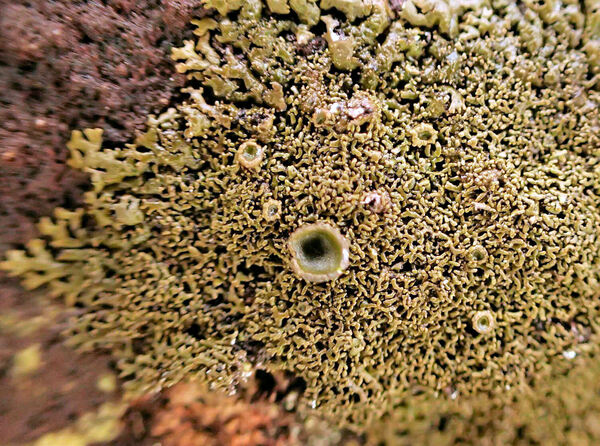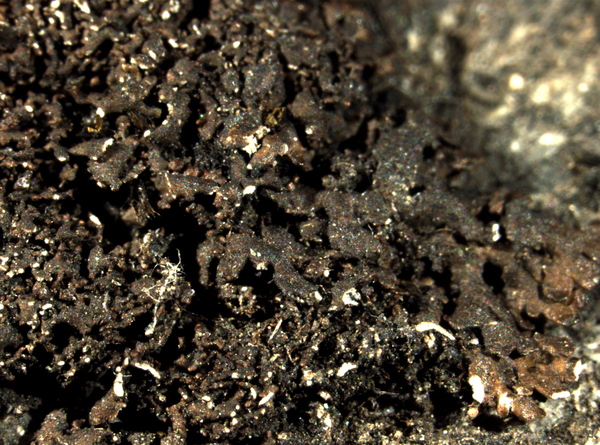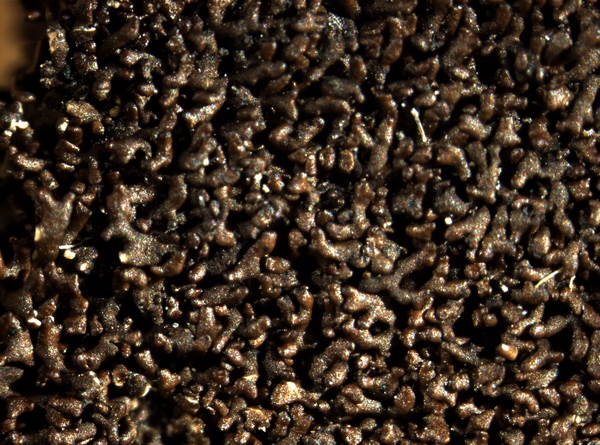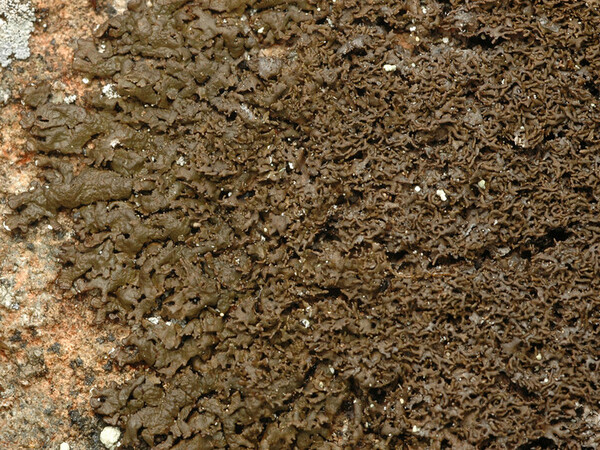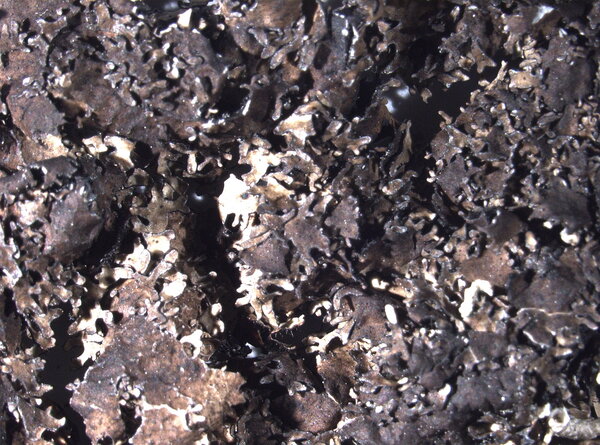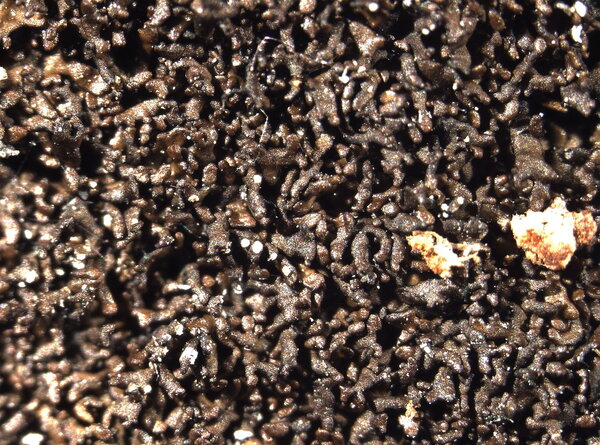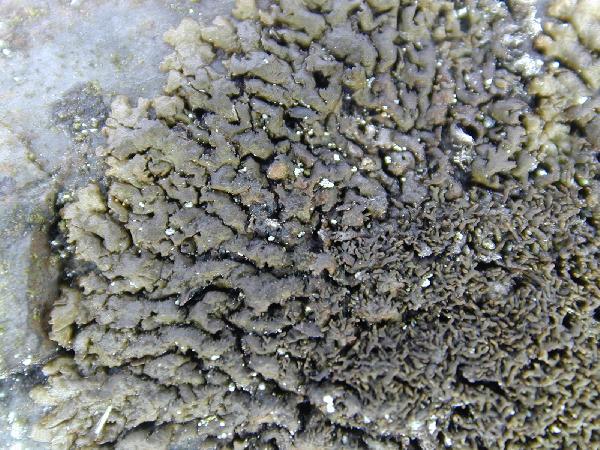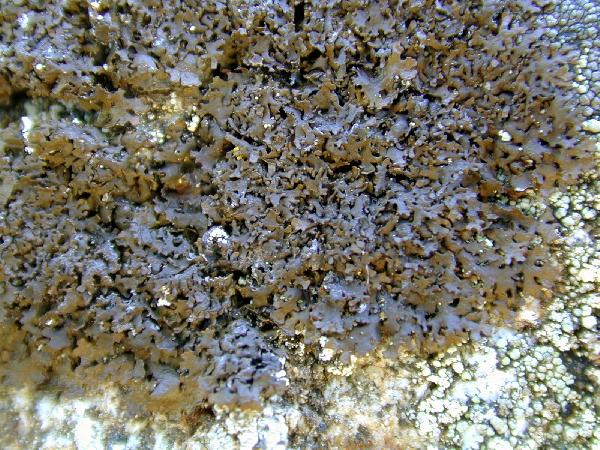Montanelia panniformis (Nyl.) Divakar, A. Crespo, Wedin & Essl.
Am. J. Bot., 99: 2023, 2012. Basionym: Parmelia olivacea var. panniformis Nyl. - Herb. Mus. Fenn.: 83, 1859.
Synonyms: Melanelia panniformis (Nyl.) Essl.; Parmelia crustificans Hilitzer; Parmelia pannariiformis (Lamy) Vain.; Parmelia panniformis (Nyl.) Vain.; Parmelia panniformis var. pulvinata Hillmann
Distribution: N - TAA (Nascimbene 2006c, Nascimbene & al. 2022), Lomb, Piem (Morisi & Sereno 1995, Isocrono & al. 2004).
Description: Thallus foliose, heteromerous, dorsiventral, adnate to loosely adnate, usually more or less panniform and sometimes pulvinate, up to 7(-10) cm in diam., the individual thalli sometimes coalescing into larger patches. Primary lobes discrete to imbricate, (0.3-)0.5-1(-1.5) mm wide, mostly flat, the central parts of thallus with crowded, imbricate, spherical to clavate, simple or slightly branched, small (< 1 mm wide) lobules resembling isidia. Upper surface olive-brown to dark brown, smooth to weakly pitted and sometimes slightly pruinose at the periphery, without pseudocyphellae on the primary lobes, sometimes with obscure pseudocyphellae near the ends of lobules. Lower surface brown to black, paler at the periphery; smooth to irregularly wrinkled, with dark, mostly simple rhizines. Upper cortex paraplectenchymatous, with a non-pored epicortex, the cell walls containing isolichenan; medulla white; lower cortex paraplectenchymatous. Apothecia rare, lecanorine, up to 3 mm across, sessile, with a concave to flat disc and a papillate to lobulate thalline margin. Epithecium brown; hymenium and hypothecium colourless. Asci 8-spored, clavate, Lecanora-type. Ascospores 1-celled, hyaline, ellipsoid, 9-12 x 4.5-7 µm. Pycnidia common, black, immersed. Conidia thickened at both ends, 4-7 x c. 1 µm. Photobiont chlorococcoid. Spot tests: upper cortex K-, C-, KC-, P-, N-; medulla K-, C-, KC- or rarely KC+ faintly pink, P-, UV+ white. Chemistry: medulla with perlatolic and stenosporic acids (major).
Note: a mainly northern species in Europe, found on steeply inclined surfaces of siliceous rocks in upland areas; almost certainly restricted to the Alps in Italy.
Growth form: Foliose, broad lobed
Substrata: rocks
Photobiont: green algae other than Trentepohlia
Reproductive strategy: mainly asexual, by thallus fragmentation
Commonnes-rarity: (info)
Alpine belt: absent
Subalpine belt: extremely rare
Oromediterranean belt: absent
Montane belt: extremely rare
Submediterranean belt: extremely rare
Padanian area: absent
Humid submediterranean belt: absent
Humid mediterranean belt: absent
Dry mediterranean belt: absent
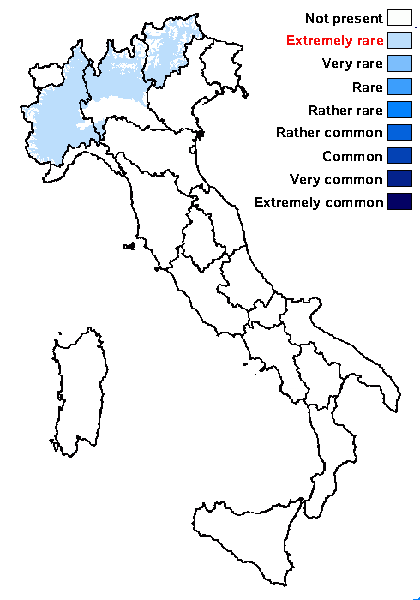
Predictive model
Herbarium samples
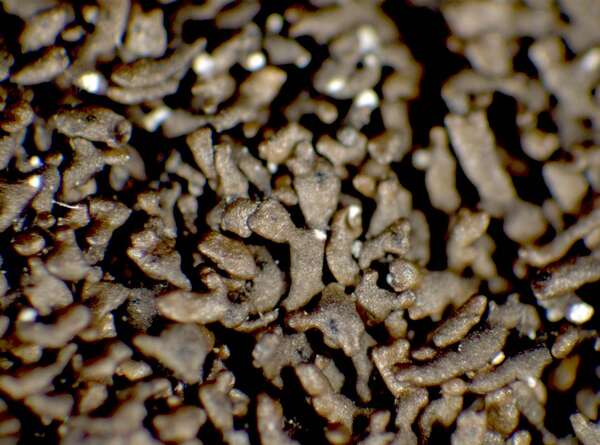

P.L. Nimis; Owner: Department of Life Sciences, University of Trieste
Herbarium: TSB (9051)
2001/12/05
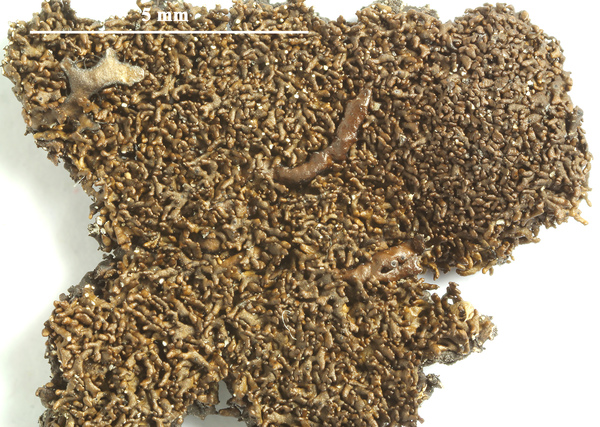

Felix Schumm - CC BY-SA 4.0
[20327], Austria, Salisburgia, Lungau, Schladminger Tauern, in valle Lessachtal, loco Lasshofer Hütte dicto, 1300-1400 m, ad saxa silicea. Leg. A. Vezda, 9.9.1981. A. VEZDA: LICHENES SELECTI EXSICCATI NR. 1870
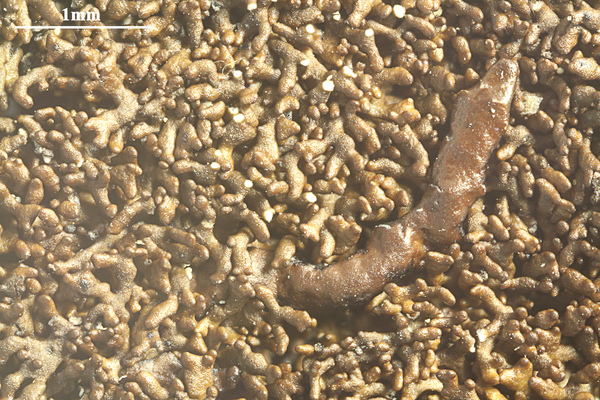

Felix Schumm - CC BY-SA 4.0
[20327], Austria, Salisburgia, Lungau, Schladminger Tauern, in valle Lessachtal, loco Lasshofer Hütte dicto, 1300-1400 m, ad saxa silicea. Leg. A. Vezda, 9.9.1981. A. VEZDA: LICHENES SELECTI EXSICCATI NR. 1870
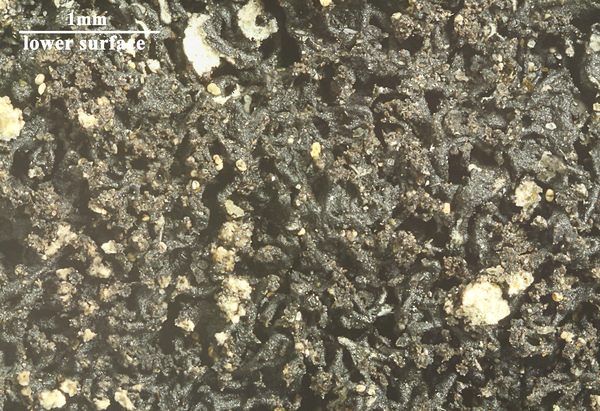

Felix Schumm - CC BY-SA 4.0
[20327], Austria, Salisburgia, Lungau, Schladminger Tauern, in valle Lessachtal, loco Lasshofer Hütte dicto, 1300-1400 m, ad saxa silicea. Leg. A. Vezda, 9.9.1981. A. VEZDA: LICHENES SELECTI EXSICCATI NR. 1870
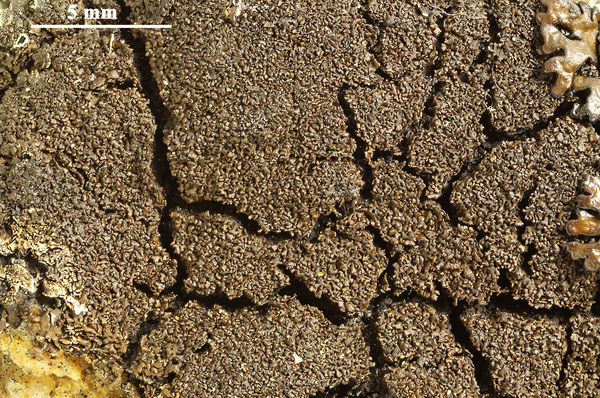

Felix Schumm - CC BY-SA 4.0
[20331], Bohemia meridionalis, Montes Šumava (Gabreta), Kašperské vrchy, distr. Prachatice, Rejštejn, in valle rivi Losenice, in pede montis Šafá v vršek, 820 m, moles saxorum, ad saxa silicea. Leg. J. Kocourková & A. Vezda, 20.10.1999. A. VEZDA: LICHENES RARIORES EXSICCATI NR. 405
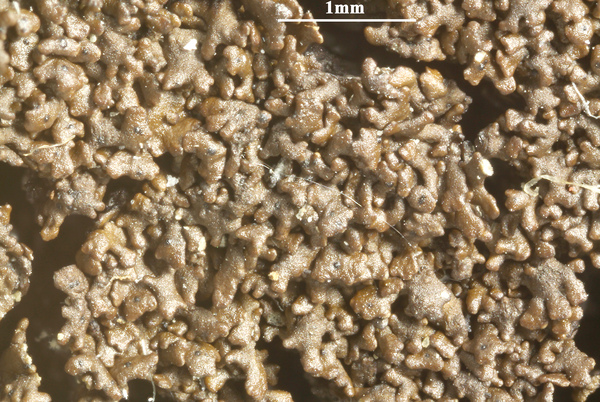

Felix Schumm - CC BY-SA 4.0
[20331], Bohemia meridionalis, Montes Šumava (Gabreta), Kašperské vrchy, distr. Prachatice, Rejštejn, in valle rivi Losenice, in pede montis Šafá v vršek, 820 m, moles saxorum, ad saxa silicea. Leg. J. Kocourková & A. Vezda, 20.10.1999. A. VEZDA: LICHENES RARIORES EXSICCATI NR. 405
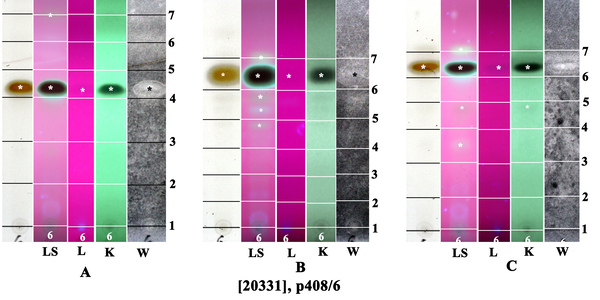

Felix Schumm - CC BY-SA 4.0
[20331], Bohemia meridionalis, Montes Šumava (Gabreta), Kašperské vrchy, distr. Prachatice, Rejštejn, in valle rivi Losenice, in pede montis Šafá v vršek, 820 m, moles saxorum, ad saxa silicea. Leg. J. Kocourková & A. Vezda, 20.10.1999. A. VEZDA: LICHENES RARIORES EXSICCATI NR. 405
p: perlatolic acid, at: atranorin (trace)
Growth form: Foliose, broad lobed
Substrata: rocks
Photobiont: green algae other than Trentepohlia
Reproductive strategy: mainly asexual, by thallus fragmentation
Commonnes-rarity: (info)
Alpine belt: absent
Subalpine belt: extremely rare
Oromediterranean belt: absent
Montane belt: extremely rare
Submediterranean belt: extremely rare
Padanian area: absent
Humid submediterranean belt: absent
Humid mediterranean belt: absent
Dry mediterranean belt: absent

Predictive model
| Herbarium samples |


P.L. Nimis; Owner: Department of Life Sciences, University of Trieste
Herbarium: TSB (9051)
2001/12/05


Felix Schumm - CC BY-SA 4.0
[20327], Austria, Salisburgia, Lungau, Schladminger Tauern, in valle Lessachtal, loco Lasshofer Hütte dicto, 1300-1400 m, ad saxa silicea. Leg. A. Vezda, 9.9.1981. A. VEZDA: LICHENES SELECTI EXSICCATI NR. 1870


Felix Schumm - CC BY-SA 4.0
[20327], Austria, Salisburgia, Lungau, Schladminger Tauern, in valle Lessachtal, loco Lasshofer Hütte dicto, 1300-1400 m, ad saxa silicea. Leg. A. Vezda, 9.9.1981. A. VEZDA: LICHENES SELECTI EXSICCATI NR. 1870


Felix Schumm - CC BY-SA 4.0
[20327], Austria, Salisburgia, Lungau, Schladminger Tauern, in valle Lessachtal, loco Lasshofer Hütte dicto, 1300-1400 m, ad saxa silicea. Leg. A. Vezda, 9.9.1981. A. VEZDA: LICHENES SELECTI EXSICCATI NR. 1870


Felix Schumm - CC BY-SA 4.0
[20331], Bohemia meridionalis, Montes Šumava (Gabreta), Kašperské vrchy, distr. Prachatice, Rejštejn, in valle rivi Losenice, in pede montis Šafá v vršek, 820 m, moles saxorum, ad saxa silicea. Leg. J. Kocourková & A. Vezda, 20.10.1999. A. VEZDA: LICHENES RARIORES EXSICCATI NR. 405


Felix Schumm - CC BY-SA 4.0
[20331], Bohemia meridionalis, Montes Šumava (Gabreta), Kašperské vrchy, distr. Prachatice, Rejštejn, in valle rivi Losenice, in pede montis Šafá v vršek, 820 m, moles saxorum, ad saxa silicea. Leg. J. Kocourková & A. Vezda, 20.10.1999. A. VEZDA: LICHENES RARIORES EXSICCATI NR. 405


 INDEX FUNGORUM
INDEX FUNGORUM
 GBIF
GBIF
 DOLICHENS
DOLICHENS
